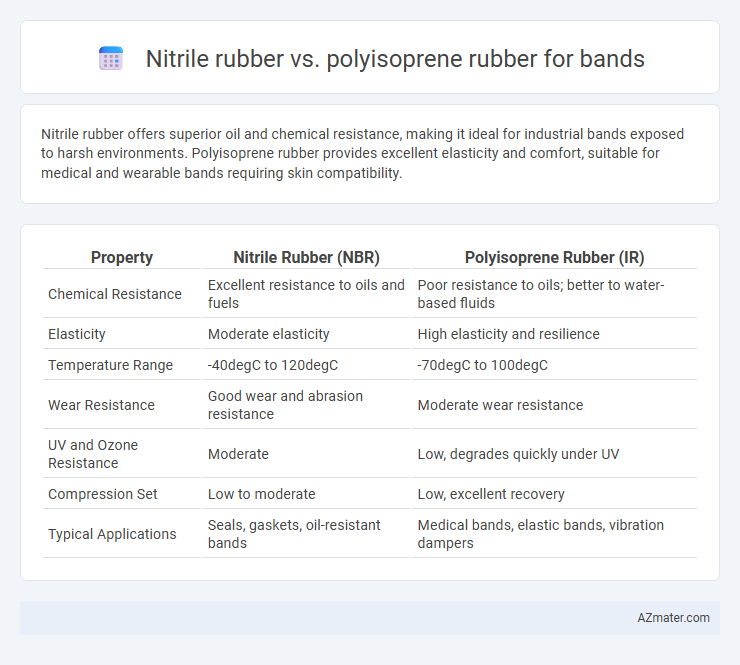Nitrile rubber offers superior oil and chemical resistance, making it ideal for industrial bands exposed to harsh environments. Polyisoprene rubber provides excellent elasticity and comfort, suitable for medical and wearable bands requiring skin compatibility.
Table of Comparison
| Property | Nitrile Rubber (NBR) | Polyisoprene Rubber (IR) |
|---|---|---|
| Chemical Resistance | Excellent resistance to oils and fuels | Poor resistance to oils; better to water-based fluids |
| Elasticity | Moderate elasticity | High elasticity and resilience |
| Temperature Range | -40degC to 120degC | -70degC to 100degC |
| Wear Resistance | Good wear and abrasion resistance | Moderate wear resistance |
| UV and Ozone Resistance | Moderate | Low, degrades quickly under UV |
| Compression Set | Low to moderate | Low, excellent recovery |
| Typical Applications | Seals, gaskets, oil-resistant bands | Medical bands, elastic bands, vibration dampers |
Introduction to Rubber Materials for Bands
Nitrile rubber (NBR) and polyisoprene rubber (IR) are widely used materials in band manufacturing due to their distinct properties. Nitrile rubber offers excellent resistance to oils, fuels, and chemicals, making it ideal for industrial and medical bands requiring durability and chemical stability. Polyisoprene rubber closely mimics natural rubber with its superior elasticity and resilience, making it suitable for applications needing high flexibility and comfort.
What is Nitrile Rubber?
Nitrile rubber, also known as NBR or Buna-N, is a synthetic elastomer widely used for bands due to its exceptional resistance to oils, fuels, and chemicals, making it ideal for industrial applications. It offers superior durability and wear resistance compared to polyisoprene rubber, which, although more similar to natural rubber, lacks the chemical resistance of nitrile. The unique copolymer structure of nitrile rubber provides excellent tensile strength and elongation, enabling bands made from NBR to perform reliably in harsh environments where polyisoprene bands would degrade faster.
What is Polyisoprene Rubber?
Polyisoprene rubber is a synthetic elastomer that closely mimics the natural rubber obtained from latex, offering excellent resilience, flexibility, and low-temperature performance. It is widely used in medical and industrial bands due to its superior elasticity and hypoallergenic properties, making it ideal for sensitive applications. Unlike nitrile rubber, polyisoprene provides better tactile sensitivity and comfort but has lower resistance to oils and chemicals.
Key Properties of Nitrile Rubber Bands
Nitrile rubber bands offer exceptional resistance to oils, fuels, and chemicals, making them ideal for industrial and medical applications where durability and chemical resistance are crucial. Their high tensile strength and excellent abrasion resistance provide long-lasting performance compared to polyisoprene rubber bands, which have superior elasticity but lower chemical resistance. Nitrile rubber's ability to withstand extreme temperatures and maintain flexibility enhances its suitability for demanding environments requiring reliable band performance.
Key Properties of Polyisoprene Rubber Bands
Polyisoprene rubber bands exhibit superior elasticity and resilience compared to nitrile rubber, making them ideal for applications requiring high flexibility and strength. These bands also offer excellent tear resistance and a natural feel, closely mimicking the properties of latex while being less allergenic. Their excellent tensile strength and low compression set ensure durable performance in various temperature ranges and repeated use scenarios.
Durability and Longevity Comparison
Nitrile rubber offers superior resistance to oils, chemicals, and abrasion, making it highly durable and ideal for industrial bands exposed to harsh environments. Polyisoprene rubber closely mimics natural rubber's elasticity and provides excellent tensile strength but is more susceptible to oxidation and UV degradation, limiting its longevity in outdoor or chemically aggressive settings. For applications demanding extended lifespan and wear resistance, nitrile rubber bands generally outperform polyisoprene options in durability and retention of mechanical properties.
Chemical Resistance: Nitrile vs Polyisoprene
Nitrile rubber exhibits superior chemical resistance compared to polyisoprene, particularly against oils, fuels, and various hydrocarbons, making it ideal for applications involving exposure to aggressive substances. Polyisoprene, while offering excellent flexibility and tensile strength, is more susceptible to degradation when in contact with oils, solvents, and certain chemicals. This distinction makes nitrile rubber the preferred choice for bands requiring durability in chemically harsh environments.
Comfort and Flexibility for Wearable Bands
Nitrile rubber offers superior chemical resistance but tends to be less flexible, which can reduce comfort in wearable bands during extended use. Polyisoprene rubber closely mimics natural rubber's elasticity and softness, providing enhanced flexibility and a comfortable, snug fit ideal for dynamic movements. For wearable bands prioritizing comfort and flexibility, polyisoprene rubber is typically the preferred choice due to its skin-friendly properties and stretchability.
Cost and Availability Analysis
Nitrile rubber offers significant cost advantages over polyisoprene rubber, primarily due to its synthetic production process and abundant raw material supply, making it more economical for large-scale band manufacturing. Polyisoprene rubber, often derived from natural sources, tends to be more expensive and subject to supply fluctuations influenced by environmental factors and agricultural yields. Availability of nitrile rubber is generally consistent and reliable globally, whereas polyisoprene rubber availability can be limited, potentially leading to higher prices and supply chain vulnerabilities.
Which Rubber is Best for Bands?
Nitrile rubber offers superior resistance to oils, fuels, and chemicals, making it ideal for industrial bands requiring durability and strength. Polyisoprene rubber provides excellent elasticity and a natural feel, preferred for fitness and sports bands where comfort and flexibility are crucial. Choosing the best rubber depends on band application, with nitrile favored for harsh environments and polyisoprene for lightweight, flexible use.

Infographic: Nitrile rubber vs Polyisoprene rubber for Band
 azmater.com
azmater.com